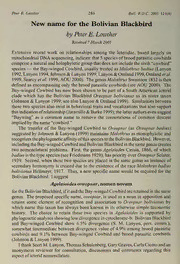
New name for the Bolivian blackbird PDF
Preview New name for the Bolivian blackbird
PeterE. Lowther 280 Bull. B.O.C. 2001 121(4) New name for the Bolivian Blackbird by Peter E. Lowther Received7March2001 Extensive recent work on relationships among the Icteridae, based largely on DNA mitochondrial sequencing, indicate that 5 species ofbroodparasitic cowbirds compris—eanaturalandholophyleticgroupthatdoesnotincludethe sixth"cowbird" species the Bay-winged Cowbird, usually treated as Molothrus badius (Lanyon 1992,Lanyon 1994,Johnson&Lanyon 1999,Lanyon&Omland 1999,Omlandetal. AOU 1999, Searcyetal. 1999, 2000). ThegenusMolothrus Swainson 1832 isthen defined as encompassing only the brood parasitic cowbirds (see AOU 2000). The Bay-winged Cowbird has now been shown to be part ofa South American icterid clade which has the Bolivian Blackbird Oreopsar bolivianus as its sister taxon (Johnson & Lanyon 1999; see also Lanyon& Omland 1999). Similarities between these two species also exist in behavioral traits and vocalizations that also support thisindicationofrelationship(Jaramillo&Burke 1999);thelatterauthorsevensuggest "Baywing" as a common name to remove the connotations of common descent impliedbythename"cowbird." The transfer of the Bay-winged Cowbird to Oreopsar (as Oreopsar badius) suggestedby Johnson & Lanyon (1999) maintainsMolothrus as monophyletic and recognizesthephylogeneticaffinityofthisspeciestotheBolivianBlackbird. However, includingtheBay-wingedCowbirdandBolivianBlackbirdinthesamegenuscreates two nomenclatural problems. First, the genus Agelaiodes Cassin, 1866, ofwhich badiusisthetype species(seeFriedmann 1929),haspriorityoverOreopsarSclater, 1939. Second, whenthese two species are placed inthe same genus an instance of secondary homonymy is created due to the existence ofthe raceMolothrus badius bolivianus Hellmayr, 1917. Thus, a new specific name would be required for the BolivianBlackbird. Isuggest Agelaioidesoreopsar,nomennovum fortheBolivianBlackbird,ifitandtheBay-wingedCowbirdareretainedinthesame genus. The proposed specific name, oreopsar, is used as a noun in apposition and retains some element of recognition and association to Oreopsar bolivianus by which name this taxon has always been known in its otherwise simple taxonomic history. The choice to retain these two species in Agelaioides is supported by phylogeneticanalysesshowinglowdivergenceincytochrome-b: BolivianBlackbird and Bay-winged Cowbird show 6.5% divergence (S. M. Lanyon, pers. comm.), somewhat intermediate between divergence value of4.9% among brood parasitic cowbirds and 9.1% between Bay-winged Cowbird and brood parasitic cowbirds (Johnson&Lanyon 1999). IthankScottM.Lanyon,ThomasSchulenberg,GaryGraves,CarlaCiceroandan anonymous reviewer for consultation, discussions and comments regarding this aspectoficteridnomenclature. 1 PeterE. Lowther 28 Bull. B.O.C. 2001 121(4) References: AOU. 2000. Forty-second supplement to the American Ornithologists' Union Check-list of North American birds. Auk 117: 847-858. Cassin, J. 1866. A study ofthe Icteridae. Proc. Acad. Nat. Sci. Philadelphia 1866: 10 - 25. Friedmann, H. 1929. The cowbirds: A study in the biology ofsocialparasitism. C. Thomas Publisher, Springfield, IL. Hellmayr, C. E. 1917. Beschreibung von sechs neuen neotropischen Vogelformen, nebst einer Bemerkung uber Ampelion cinctus (Tsch.). Verh. Orn. Gesell. Bayern 13: 106-110. Jaramillo, A. & Burke, P. 1999. New World blackbirds. The icterids. Princeton Univ. Press, Princeton, New Jersey. Johnson, K. P. & Lanyon, S. M. 1999. Molecular systematics ofthe grackles and allies, and the effect of additional sequence (cyt b and ND2). Auk 116: 759-768. Lanyon, S. M. 1992. Interspecific brood parasitism in blackbirds (Icterinae): A phylogenetic perspective. Science 255: 77-79. Lanyon, S. M. 1994. PolyphylyoftheblackbirdgenusAgelaius andthe importance ofassumptions ofmonophyly in comparative studies. Evolution 48: 679-693. Lanyon, S. M. & Omland, K. E. 1999. A molecular phylogeny ofthe blackbirds (Icteridae): Five lineages revealed by cytochrome-^ sequence data. Auk 116:629-639. Omland, K. E., Lanyon, S. M. & Fritz, S. J. 1999. Amolecularphylogeny oftheNewWorldorioles (Icterus): The importance ofdense taxon sampling. Molec. Phylogenet. Evol. 12: 224-239. Searcy, W. A., Yasukawa, K. & Lanyon, S. M. 1999. Evolution ofpolygyny in the ancestors of Red-winged Blackbirds. Auk 116: 5-19. Sclater, W. L. 1939. A note on someAmerican Orioles ofthe family Icteridae Ibis (14), 3: MO- Address: Peter E. Lowther, The Field Museum, 1400 South Lake Shore Drive, Chicago, Illinois 60605-2496, USA. E-Mail: [email protected] © British Ornithologists' Club 2001 The correct name of the Iberian Chiffchaff Phylloscopus ibericus Ticehurst 1937, its identification and new evidence of its winter grounds by Lars Svensson Received26April2001 The Iberian Chiffchaff, whether regarded as a subspecies ofCommon Chiffchaff Phylloscopus collybita or a separate species, has been known as both brehmii (Homeyer1871)andibericusTicehurst 1937.Thecurrent'official'nameistheformer; e.g. the Records Committee ofthe British Ornithologists' Union lists it as Iberian ChiffchaffPhylloscopusbrehmii(Homeyer)(B OU2001). However, Idemonstrate belowthatthe correctname shouldbeP. ibericus. Inrecentyears,closestudyoftheIberianChiffchaffhasrevealedreasonsforitto betreatedasaseparatespecies,mainlyduetotheeffortsofMarc Salomon(Salomon
